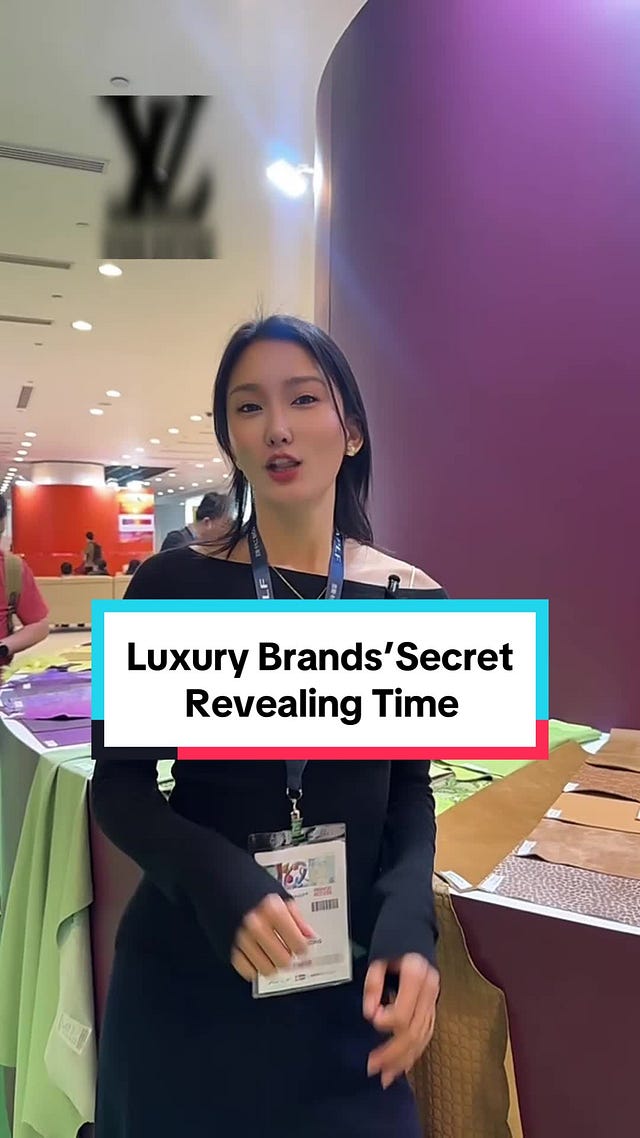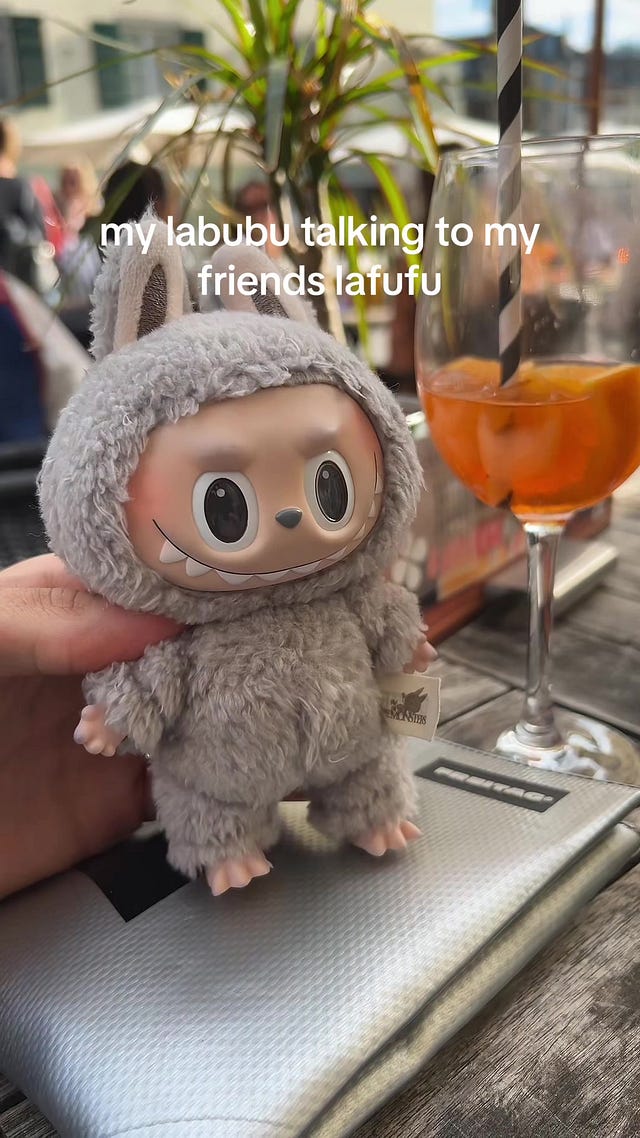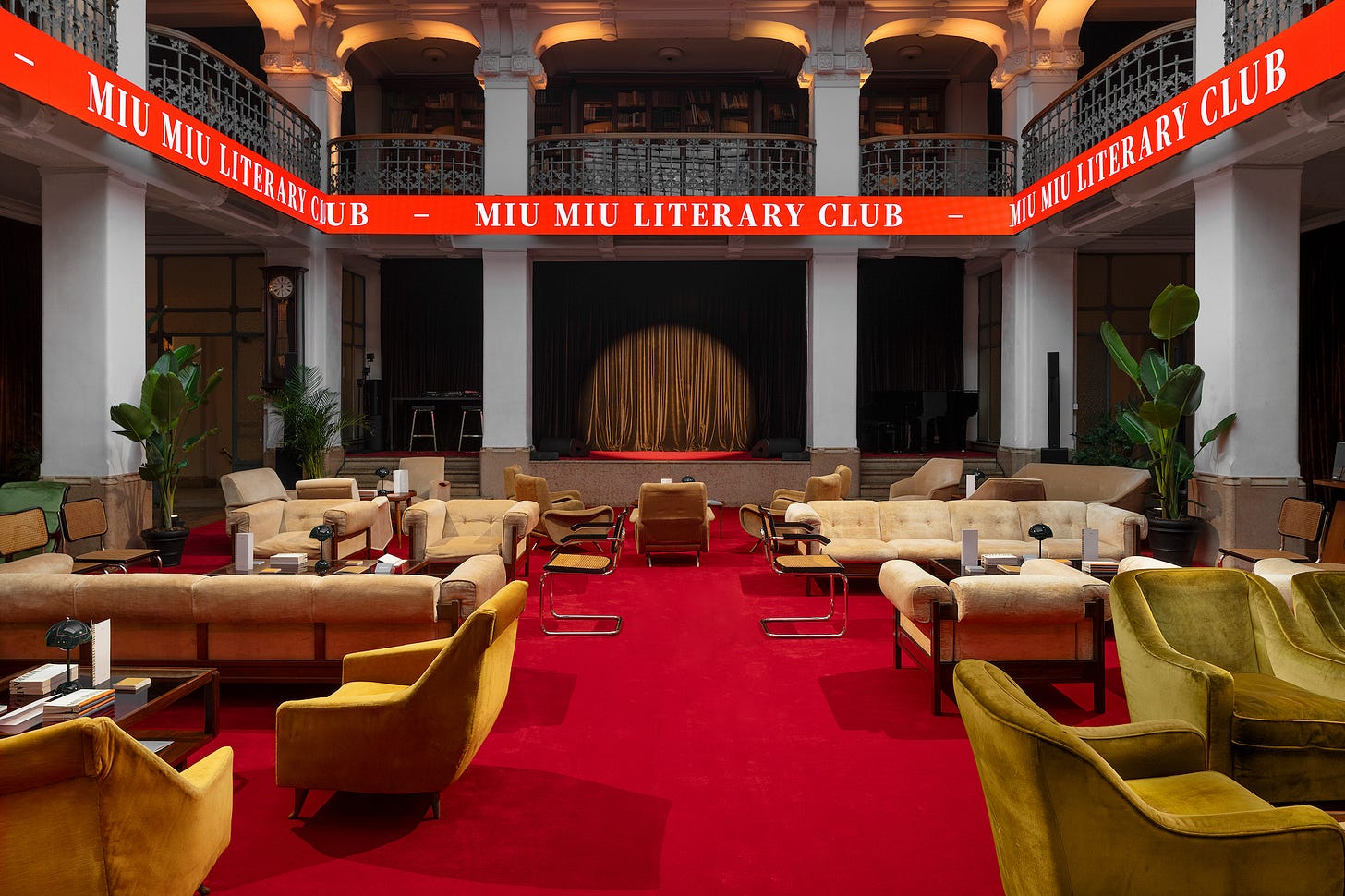Performative Luxury and Other Contemporary Fictions
Between irony, desire and algorithm, the new theater of distinction turns luxury into performance, language, and a shared illusion.
Not long ago, I shared a reflection on LinkedIn about cultural capital, Bourdieu, and the aestheticization of repertoire. It all started when my TikTok For You page was taken over by videos on how to acquire cultural capital — along with critiques of this “performed intellect” aesthetic. Coincidentally, I was diving into Bourdieu’s work at the time and felt compelled to add my two cents to the conversation.
But here on Substack, where I’ve allowed myself to explore these themes with more depth, I want to approach this symbolic field from another angle. Not through the lens of intellectual aestheticization, but down a parallel path: one where luxury becomes collective performance, symbolic play, and a desired fiction.

Luxury has never been solely about ownership. Since its origin, it has existed in the realm of the symbolic: a system of signs and social codes that define what is worthy of desire, preservation, and display. In 2025, what has changed is not the desire itself, but the way it is staged. Luxury remains a powerful cultural language, now shaped by conscious performativity, irony, and, paradoxically, a growing illusion of access.
We know the stage is set, and yet, we still long to be part of the play.
Replicas, factories, and “transparency”
The production of major maisons has long been shrouded in mystery, marked by exclusivity and industrial secrecy. But recently, that landscape has begun to shift radically.

Several Chinese companies have begun publicly revealing that they manufacture for major luxury brands, using this connection as a form of reverse credibility. A phenomenon that aligns with the idea of luxury’s demystification. On TikTok, viral videos have exposed which leather suppliers serve top brands during major industry trade shows, unveiling a production chain that was previously inaccessible to the average consumer (or to lesser-known manufacturers). This “exposed” moment is a turning point: it destabilizes the traditional aura of exclusivity in luxury and calls into question the symbolic value rooted in inaccessibility.

 Tiktok failed to load.
Tiktok failed to load.Enable 3rd party cookies or use another browser
Even with the advancement of authentication technologies, such as artificial intelligence, blockchain, and platforms like Entrupy, Vestiaire Collective, and The RealReal, authenticity remains fallible. In many cases, only highly trained experts can tell the difference between an original and a replica. This reinforces the notion that value is no longer grounded in institutional verification, but in performative staging.
Consumers have begun seeking nearly identical versions of bags and accessories, fully aware they are not originals, but that they carry the same materiality and aesthetic. Here, value shifts from institutional authenticity to belonging within a symbolic and performative language.
This phenomenon can be interpreted through Pierre Bourdieu’s theory of cultural capital (yes, him again 😅), which he defines as a set of competencies, knowledge, and tastes that distinguish social groups. It’s important, however, to differentiate between repertoire and capital: while capital can be objectified and performed (through clothing, books, travel), repertoire, such as aesthetic experience, critical reading, or familiarity with subtle codes, is embodied and harder to simulate. Some forms of symbolic access, no matter how much effort is made, remain out of reach, many of us may rise socially through education and work, but we’re unlikely to ever have the Rothschilds in our contact list.
We can also turn to Jean Baudrillard, for whom consumption is a system of signs, not needs. In this sense, the replica does not represent an absence of value, but a reorganization of meaning. The simulacrum of a luxury bag is not merely an imitation; it is a sign in itself, operating within the same symbolic logic as the original.
Labubus and Lafufus: the luxury of the affective duplicate
Yes, them again.
It’s highly unlikely this phenomenon hasn’t shown up in at least one of your feeds recently. These collectible dolls, especially beloved by young adults, illustrate the complexity of performative luxury consumption today. While original Labubus are limited, expensive, and coveted, their replicas, affectionately nicknamed Lafufus, are more accessible and widely available, sold on platforms like Shopee, AliExpress, and local markets the world.
Interestingly, many consumers own both, without attempting to hide the duality. On TikTok, countless videos feature interactions between the real and the fake — often in trending formats. It’s worth noting the creativity of the replica market and the increasingly charming features of the Lafufus. This relationship transcends mere counterfeiting and becomes a playful, critical, and self-aware gesture about the fluid nature of symbolic value.
Here, the line between original and replica becomes blurred, reinforcing the idea that the value of luxury lies less in the object itself and more in the scene, in the performative gesture, in the social make-believe that sustains distinction.
Luxury as Staged Aesthetic
The report “What Consumers Want from Luxury in 2025”, by Vogue Business, notes that 82% of consumers want luxury to reflect personal values and emotional connections. Ostentatious status gives way to performative authenticity and a quiet aesthetic of knowledge and refined taste, often merely staged.
On social media, videos about quiet luxury (even featuring Zara pieces) or how to dress like old money are everywhere, showing how the aesthetics of luxury have become a replicable, applicable, and performable filter. Luxury doesn’t need to be real — it just needs to look real on the feed. It’s less about acquisition and more about performance: knowing the codes, the language, the angles.
Recently, some brands have ramped up efforts to generate symbolic value through cultural repertoire, shifting the focus from product to knowledge. Miu Miu, for instance, has launched pop-ups distributing books and now promotes reading clubs; Chanel, in addition to running a podcast on art and culture with curators and thinkers, launched its own magazine in 2025, reinforcing the brand’s positioning as an active agent in cultural discourse. The publication features content on art, literature, and aesthetics, functioning almost as a visual and editorial manifesto of its commitment to intellectual sophistication.
These movements signal an attempt to reposition luxury as a catalyst for reflection and cultural depth, a response to the growing fatigue with "aesthetic cores" and the TikTokification of style.
In line with this symbolic shift, Dior recently launched handbags printed with covers of classic literary works — from Virginia Woolf to Marcel Proust. More than a purely aesthetic gesture, this choice reflects a clear attempt to elevate the product to the status of a cultural artifact. The bag ceases to be merely an accessory and begins to function as an index of cultural repertoire, a "portable library" that signals belonging to a symbolic elite. This gesture connects fashion and knowledge, object and discourse, turning consumption into a performative cultural statement.
Perhaps we are witnessing fashion’s return to existential questions, where intelligence, emotion, and depth once again become symbolic markers of distinction. More than visual status, what is sought now is density. In a landscape saturated with images and simulations, value shifts toward embodied repertoire.
We can also draw from Bauman’s reflections on "liquid modernity" and the transformation of desire into constant flow: a hunger that is never satisfied. Performative luxury fits within this logic: prestige is enacted, but full belonging is never truly attained. The performance is endless. Each new gesture of distinction triggers the need for another. Contemporary luxury is a continuous process of maintaining a projected identity.
Lipovetsky, in turn, reminds us that we live in a society of lightness and seduction. Luxury is no longer about historical weight, heritage, or tradition — it is about fleeting, aestheticized, sensory experiences. Distinction now stems not from solidity, but from the ability to enchant momentarily.
This scenario becomes even more complex when we look at the Brazilian context. According to a study by Consumoteca, shared by Michel Alcoforado during the most recent VTEX Day, more than two-thirds of Gen Z youth in Brazil say luxury consumption is a financial goal. Among them, 67% state they aspire to this sophisticated and hard-to-access lifestyle. While Boomers and Gen X, even with greater purchasing power, show less interest, younger generations associate luxury with identity, belonging, and a symbol of social value.
This attachment to luxury as aspiration cannot be explained by consumption alone. It’s about visibility, validation, and success narrative. A generation raised among unboxings, algorithms, and aspirational feeds no longer sees luxury as an exception, but as part of the everyday repertoire. Even when inaccessible, luxury operates as a symbolic horizon.
When value is theater
According to a 2025 report by Vogue Business, 71% of consumers expect brands to offer something exclusive, “that cannot be found anywhere else.” But how can exclusivity be sustained when accessible replicas now fulfill the symbolic role of the original?
In Asia, luxury consumption is deeply performative. As reported in “The new rules for selling luxury in China, Japan and Southeast Asia” (Vogue Business), 96% of Chinese consumers perceive luxury as an immersive experience, more a social performance than a possession. Brands have responded with sensory pop-ups, VIP events, and theatrical activations that place the consumer at the center of a narrative of distinction.

The new luxury is no longer sustained by scarcity or tradition alone, but by its ability to communicate a worldview. Figures like Jonathan Anderson — who recently took over as creative director at Dior — exemplify this shift: designers who operate as cultural curators, art collectors, visual thinkers, and inheritors of a trained and singular gaze. Choosing names like these isn’t just an aesthetic move; it’s strategic. It reflects a brand’s desire to align with rare intelligences capable of generating symbolic value at a moment when the tangible is no longer enough.
This signals a broader cultural transformation: luxury becomes spectacle, and the product, a souvenir of the performed moment.
The Illusion of Access
Access to the codes of luxury has, paradoxically, become more important than actual ownership. The old money aesthetic found in thrift stores, handbags produced in the same factories as official brands, cult toys and their replicas, all converge toward a logic of consumption based on the feeling of belonging to the theater of prestige.
Luxury is not dead. But it has undergone a remarkable mutation: from object to gesture, from ownership to performance. It has metamorphosed into performative effect. Consumers who understand the theater take part with irony, humor, or genuine desire, turning access into an illusion, yet one that still brings real pleasure.
This shift is happening at a critical moment. According to the report Luxury Hits an Inflection Point (Vogue Business), the global luxury sector is experiencing a major slowdown: stagnating sales, high inventory levels, and increasingly cautious consumers , especially among younger generations. The market is estimated to have grown only 4% in early 2025, after years of post-pandemic acceleration. The Bain & Company report, cited by the Business of Fashion, forecasts that this deceleration will likely continue into 2026, pushing brands to rethink their strategies and narratives.
This crisis of desire especially affects categories once seen as ultimate status symbols — logo-heavy bags, monogrammed prints, and easily identifiable products. Brands like The Row, Loro Piana, and Toteme now represent a quieter form of sophistication, rooted in noble fabrics, precise tailoring, neutral color palettes, and above all, the absence of logos. A kind of luxury that doesn’t declare itself : it simply is, for those who know how to see. The rise of quiet luxury signals a reconfiguration of desire: moving from the explicit to the subtle, from the visible to the codified.
Yet as these new codes become recognizable and replicable, through fast fashion or viral aesthetics, they too dissolve into performance. What remains, often, is the symbolic gesture: the image of luxury, even without its traditional substance.
Millennials, Irony, and the Conscious Consumer
Millennials also play a central role in this analysis. This generation captures the paradoxes of contemporary luxury with precision. Born between 1981 and 1996, they grew up under the influence of 1990s consumerism, the rise of brands as cultural icons, and later, the 2008 financial crisis, which deeply shook their relationship with status, stability, and economic promise.
According to the recent Vogue Business article Understanding the Millennial Consumer, millennials have become selective, strategic, and emotionally intelligent in their purchasing habits. More than brand loyalty, they seek symbolic alignment, something that resonates with their values, lived experiences, and projected identity. Brands that deliver only the object lose ground; what holds value now is the narrative: whether personal, ethical, or aesthetic.
This helps explain millennials' comfort with conscious replicas or "almost originals." Their relationship with authenticity is now mediated by context, intention, and aesthetics, no longer by institutional ownership. An item may not be officially signed by a maison, yet still carry the symbolic language that places it within the system of visual distinction.
Moreover, millennials cultivate a kind of cultural irony that allows them to play with the codes of luxury. It’s common to see them wearing pieces that imitate brand design in a parodic or openly fake way — not as an attempt at deception, but as commentary on the very value system we attach to objects.
 Tiktok failed to load.
Tiktok failed to load.Enable 3rd party cookies or use another browser
Under Demna’s creative direction, Balenciaga has become a symbol of this paradox. Known for pushing the boundaries between the banal and the sophisticated, Demna positions his aesthetic within the realm of anti-fashion and extreme normcore. His collections are marked by exaggeration, deconstruction, and pieces inspired by everyday objects—trash bags, masking tape, or handbags that resemble snack packaging. In doing so, he exposes the symbolic logic of contemporary luxury, elevating the ordinary to fetish status.
This radical approach was quickly absorbed, and parodied, by consumers. Several viral videos, especially in 2022, mimicked Balenciaga campaigns using actual trash bags worn over the shoulder, poking fun at the brand’s aesthetic narrative. The mockery doesn’t cancel out desire; quite the opposite, it reveals the game. Today, luxury can be revered and ridiculed at the same time, without losing its value.
This behavior aligns with the idea of “performative consumption” and “aesthetic media,” in which objects no longer hold value solely in themselves but become tools for curating and expressing personal identity. It’s a form of self-curation, where everything one wears, buys, and shares helps construct a real-time personal narrative.
By blending desire and critique, millennials don’t just blur the lines between authenticity and imitation, they expose the fragility of those categories in a landscape where symbols matter more than origins. In this new logic, what matters is not just knowing the codes, but knowing when to use them sincerely or ironically.
The Jewelry Boom: Quiet and Emotional Luxury
While traditional luxury categories like bags and clothing face notable slowdowns—marked by excess inventory and less excitement around seasonal collections—the high-end jewelry market has quietly gained prominence. The State of Fashion: Luxury report (BoF + McKinsey) highlights how, even in a global climate of uncertainty and declining sales among established brands, the jewelry sector continues to grow in a steady, sustained way. This trend has been echoed in several Business of Fashion articles, including “Why Jewellery Feels Like a Better Deal Than a Handbag” and “The Jewellery Boom Explained.”
Much of this shift comes from younger consumers’ changing mindsets. Millennials and Gen Z are prioritizing more intentional purchases—ones with lasting symbolic and financial value. In this context, jewelry not only endures trends and time, but also offers a sense of emotional investment. It carries sentimental meaning, is tied to life milestones, and can be passed down through generations. What’s being purchased isn’t just an accessory: it’s a story.
Unlike bags and clothes that often display more overt status signals—logos, iconic silhouettes, bold branding, jewelry operates on a different symbolic frequency. It’s more intimate, subtle, and quiet. This understated nature positions jewelry as an emblem of what’s now called stealth wealth, a direct offshoot of the quiet luxury aesthetic, which rejects flashiness in favor of coded sophistication.
Brands like Cartier, Tiffany & Co., and Bulgari have leaned into legacy, heritage, and emotion. Rather than urgency, scarcity, or trends, they offer longevity and emotional resonance. At the same time, independent jewelry houses have grown by focusing on personalization and the creation of unique, story-driven pieces. This aligns with a rising expectation: that luxury should mean something beyond just image.
As a result, jewelry hasn’t just survived luxury’s recent crisis of desire, it has transcended it. Today, it represents a new kind of distinction, where the symbol doesn’t need to be visible to hold value. And in doing so, it helps reshape contemporary desire: not loud logomania, but a whispered kind of wealth tied to memory.
Luxury Under Pressure
The luxury market is at an inflection point. According to Luxury Hits an Inflection Point (Vogue Business), the recent slowdown is not just cyclical but structural. Major maisons are facing stock surpluses, fewer repeat purchases, and increasing difficulty in justifying price hikes to a more discerning, less easily impressed consumer. There are clear signs of symbolic saturation, especially in traditional categories like bags and clothing, which until recently were cornerstones of visible prestige.
This shift is deepened by a diffuse sense of cultural exhaustion. The strategies of exclusivity, scarcity, and logomania that once sustained luxury now feel insufficient in the face of contemporary desire, one that is more fluid, more self-aware.
Brands have responded with strategic repositioning, archival revivals, investments in heritage storytelling, and experimental activations. It’s as if they’re trying to rediscover symbolic value. But the crisis isn’t just about positioning: it’s about meaning. Brand authority is being challenged not only by replicas and affordable alternatives, but by a new grammar of prestige spreading across social media in the form of aesthetic irony, cultural remix, and performative consumption.
Faced with so many possible futures, perhaps we’re already crossing a threshold of symbolic exhaustion. The proliferation of generic aesthetics, interchangeable brands, and products that feel like minor variations of the same visual script suggest that differentiation by form has lost its strength. Prestige is no longer sustained by replicable image, it now demands depth.
In the past, logos, silhouettes, and materials were enough to evoke luxury. Today, it seems necessary to communicate a worldview. The new asset isn’t the object itself, but the cultural repertoire it activates. In a market saturated with signs, what stands out is the ability to mean something.
No wonder symbolic shortcuts and performative codes, almost-original bags, cult toys and their replicas, are gaining ground. When traditional luxury loses its grip, desire reinvents itself, detaching symbol from seal. What used to be vertical and controlled becomes remixed, parodied, and reconstructed in real time by an audience that understands the game, and plays it better than ever.
In the end, what’s at stake is not just brand value, but the value we assign to symbols. When anyone can stage the symbol, what truly distinguishes?
Maybe it’s no longer about what you own, but how deeply you understand that this is all theater: a collective stage where the performance of luxury becomes, at once, resistance, irony, and desire.






